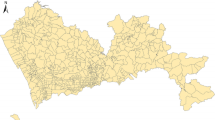Abstract
Detecting the high-risk zones as well as potential infected geographical neighbor is necessary and important to reduce the loss caused by infectious disease. However, it is a challenging work, since the outbreak of infectious disease is uncertain and unclear. Moreover, the detection should be efficient otherwise the best control and prevention time may be missed. To deal with this problem, we propose a geography high-risk zones detection method by capturing the significant change in the infectious disease monitoring data. The main contribution of this paper includes: (1) Analyzing the challenges of the early warning and detection of infectious disease outbreak; (2) Proposing a method to detect the zone that the number of monitoring cases changes significantly; (3) Defining the infection perturbation to describe the infection probability between two zones; (4) Designing an algorithm to measure the infection perturbation of infectious disease between adjacent zones; (5) Performing extensive experiments on both real-world data and synthetic data to demonstrate the effectiveness and efficiency of the proposed methods.
This work was supported by the National Natural Science Foundation of China under grant No. 61103042, the National Research Foundation for the Doctoral Program by the Chinese Ministry of Education under grant No.20100181120029, and the Young Faculty Foundation of Sichuan University under grant No. 2009SCU11030.
Access this chapter
Tax calculation will be finalised at checkout
Purchases are for personal use only
Preview
Unable to display preview. Download preview PDF.
Similar content being viewed by others
References
Kulldorff, M.: A Spatial Scan Statistic. Communications in Statistics: Theory and Methods 26(6), 1481–1496 (1997)
Kulldorff, M., Huang, L., Pickle, L., Duczmal, L.: An Elliptic Spatial Scan Statistic. Statistics in Medicine 25(22), 3929–3943 (2006)
Takahashi, K., Kulldorff, M., Tango, T., Yih, K.: Flexibly Shaped Space-time Scan Statistic for Disease Outbreak Detection and Monitoring. International Journal of Health Geographics 7, 14 (2008)
Jung, I., Kulldorff, M., Klassen, A.: A Spatial Scan Statistic for Ordinal Data. Statistics in Medicine 26(7), 1594–1607 (2007)
Huang, L., Kulldorff, M., Gregorio, D.: A Spatial Scan Statistic for Survival Data. Biometrics 63(1), 109–118 (2007)
Huang, L., Tiwari, R.C., Zou, Z., Kulldorff, M., Feuer, E.J.: Weighted Normal Spatial Scan Statistic for Heterogeneous Population Data. Journal of the American Statistical Association 104(487), 886–898 (2009)
Wong, W.K., Moore, A., Cooper, G., Wagner, M.: Rule-based Anomaly Pattern Detection for Detecting Disease Outbreaks. In: Proc. the 18th National Conference on Artificial Intelligence (AAAI 2002), pp. 217–223. MIT Press (2002)
Wong, W.K., Moore, A., Cooper, G., Wagner, M.: Bayesian Network Anomaly Pattern Detection for Disease Outbreaks. In: Proc. the 20th International Conference on Machine Learning (ICML 2003), pp. 808–815. AAAI Press (2003)
Wong, W.K., Moore, A., Cooper, G., Wagner, M.: What’s Strange About Recent Events (WSARE): An Algorithm for the Early Detection of Disease Outbreaks. Journal of Machine Learning Research 6, 1961–1998 (2005)
Wagner, M.M., Tsui, F.C., Espino, J.U., Dato, V.M., Sittig, D.F., Caruana, R.A., McGinnis, L.F., Deerfield, D.W., Druzdzel, M.J., Fridsma, D.B.: The Emerging Science of Very Early Detection of Disease Outbreaks. Journal of Public Health Manag. Pract. 7(6), 51–59 (2001)
Centers for Disease Control and Prevention. Updated Guidelines for Evaluating Public Health Surveillance Systems: Recommendations from the Guidelines Working Group. MMWR 50(RR-13): 1-35 (2001)
Russell, K.L., Rubenstein, J., Burke, R.L., Vest, K.G., Johns, M.C., Sanchez, J.L., Meyer, W., Fukuda, M.M., Blazes, D.L.: The Global Emerging Infection Surveillance and Response System (GEIS), a U.S. Government Tool for Improved Global Biosurveillance: a review of 2009. BMC Public Health 11(suppl. 2), S2 (2011)
Agresti, A.: An Introduction to Categorical Data Analysis, 2nd edn., New Jersey. Wiley Series in Probability and Statistics (2007)
Kullback, S., Leibler, R.A.: On Information and Sufficiency. The Annals of Mathematical Statistics 22(1), 79–86 (1951)
Cover, T., Thomas, J.: Elements of Information Theory. Wiley Series in Telecommunications. John Wiley and Sons, New-York (1991)
Hershey, J., Olsen, P.: Approximating the Kullback Leibler Divergence between Gaussian Mixture Models. In: Proc. of ICASSP, Honolulu, USA (2007)
Minka, T.: Divergence Measures and Message Passing. Technical Report MSR-TR-2005-173, Microsoft research, Cambridge (2005)
Author information
Authors and Affiliations
Editor information
Editors and Affiliations
Rights and permissions
Copyright information
© 2012 Springer-Verlag Berlin Heidelberg
About this paper
Cite this paper
Tan, B. et al. (2012). Detection of High-Risk Zones and Potential Infected Neighbors from Infectious Disease Monitoring Data. In: Yu, H., Yu, G., Hsu, W., Moon, YS., Unland, R., Yoo, J. (eds) Database Systems for Advanced Applications. DASFAA 2012. Lecture Notes in Computer Science, vol 7240. Springer, Berlin, Heidelberg. https://doi.org/10.1007/978-3-642-29023-7_27
Download citation
DOI: https://doi.org/10.1007/978-3-642-29023-7_27
Publisher Name: Springer, Berlin, Heidelberg
Print ISBN: 978-3-642-29022-0
Online ISBN: 978-3-642-29023-7
eBook Packages: Computer ScienceComputer Science (R0)




